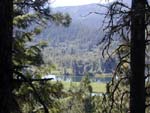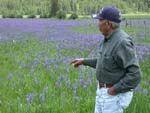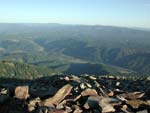|
 | | St. Joe River |
|
|
The Creator and the First Peoples have endowed the lands and the waters with numerous "gifts" of plants, fishes, birds and animals. In this section we will explore some of these plant and animal "gifts" and learn of their continued significance and use by the Schitsu'umsh people.
 | | Flowering Camas Field |
There are various ritual activities associated with the gathering of the plant foods and the hunting of the game animals. Taken together these rituals serve as a means for acknowledging and giving thanks for the "gifts" bestowed upon the human peoples by the Amotqn (Creator) and First Peoples (Coyote and Chief Child of the Yellow Root, for example), as well as the means for helping care for and perpetuate those gifts, and, in turn, share them with family members in need of assistance. In addition to suumesh songs (spiritual power) and mi'yep "teachings" (values), among the "gifts" received and shared are the camas roots and huckleberry fruits, and venison and salmon meats. These are gifts that nourish and heal both the body and spirit.
|
|
Cliff SiJohn considers some of the important and abundant "gifts" provided to the Shitsu'umsh (interviewed and edited by Rodney Frey, August 2002) |
 | | View From Grassy Mountain |
Before any camas or bitterroot is dug, any huckleberries or serviceberries gathered, or a deer or elk hunted, prayer is first offered. Addressing the Creator and the plant or animal itself, permission is sought to begin the gathering or hunt, along with a request for success. After the pitse' (digging stick) has loosened the soil and the first camas bulb is removed, its blue flowers are placed back into the earth, along with an offering of tobacco or qhasqhs (a "medicine root"). When the "water potato" roots are being gathered an elder will say, "Remember those who could not make it down here today and when you finish take a few of these roots and give them to the elders and children." Before the berry gathering begins, an elder will go to the berry bushes and bring a small branch back to a "grandmother." She will eat the first berries, reminding all of the role of the mothers. In gathering the berries, they are to be "combed out" of the bushes so as not to injure the huckleberry. When the berry gathering is completed, a basket of the berries is left in a tall tree, for the Creator, as an offering. Before the hunter goes out he will sing his suumesh hunting songs. After the "deer has offered itself," the hunter will again sing a set of hunting songs of each stage of the butchering of the meat. In all instances, only the amount of roots or meat necessary for the family's needs is gathered or hunted - "never take too much." As with the roots and berries, meat is distributed to all those in need, the elders, the sick, and the households without a hunter. It is a ritual act that is learned early in life. After a young boy or girl gets his first rabbit, deer or elk, he or she will have a feast for all the family members. All will share in the meat, except the hunter, to "remind him of his role as a provider." As the deer has offered itself up to the hunter, so too should the hunter offer this meat to those in need.
© Coeur d'Alene Tribe 2002
next >
|
|
|










